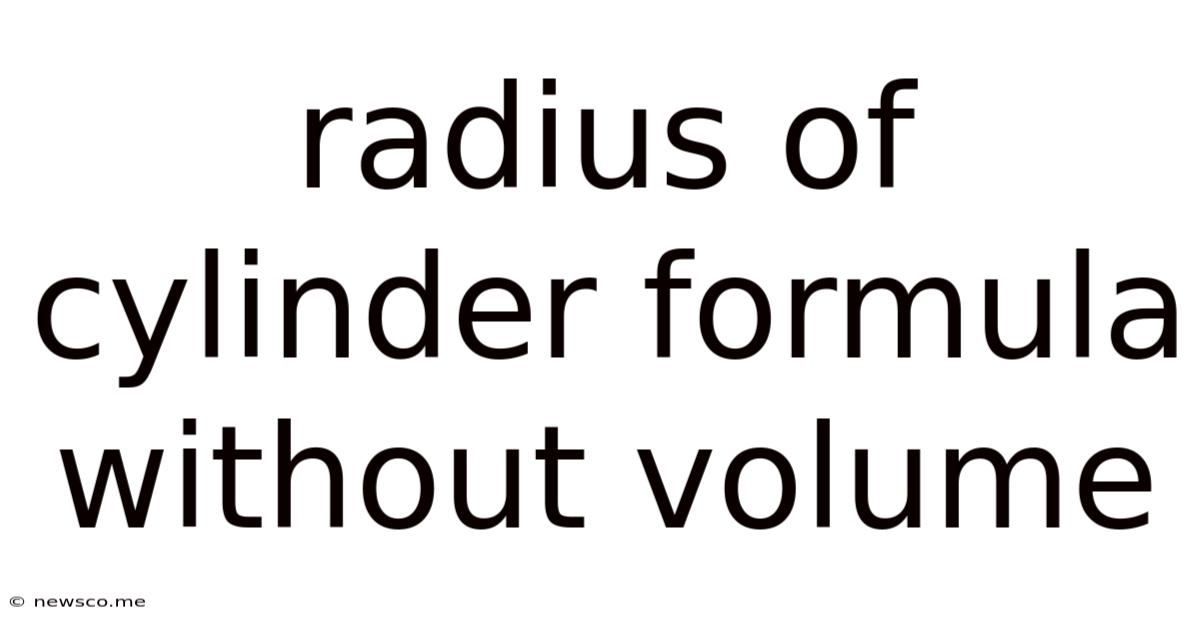Radius Of Cylinder Formula Without Volume
News Co
May 08, 2025 · 4 min read

Table of Contents
Radius of a Cylinder Formula: Beyond Volume Calculations
Determining the radius of a cylinder isn't solely reliant on knowing its volume. While volume is a common element in cylinder calculations, several other approaches can effectively reveal the radius, depending on the information available. This comprehensive guide explores various methods to calculate the cylinder's radius without using its volume, focusing on practical applications and underlying mathematical principles.
Understanding Cylinder Geometry: Key Elements
Before delving into the formulas, it's crucial to understand the fundamental components of a cylinder:
- Radius (r): The distance from the center of the circular base to any point on the circumference. This is the primary focus of this guide.
- Diameter (d): Twice the radius (d = 2r). Knowing the diameter directly provides the radius.
- Height (h): The perpendicular distance between the two circular bases.
- Circumference (C): The distance around the circular base (C = 2πr). Circumference provides a direct path to calculating the radius.
- Surface Area (SA): The total area of the cylinder's surface, including the two circular bases and the lateral surface. The formula incorporates radius and height.
Methods to Calculate the Radius of a Cylinder Without Volume
Several scenarios allow for radius calculation without needing the volume. Let's examine these methods individually:
1. Using the Diameter
The simplest method involves knowing the cylinder's diameter. Since the diameter (d) is twice the radius (r), the formula is straightforward:
r = d / 2
Example: If a cylinder has a diameter of 10 cm, its radius is 10 cm / 2 = 5 cm.
This method is efficient and requires minimal calculation. It's ideal when the diameter is directly measurable.
2. Using the Circumference
The circumference (C) of the cylinder's base is directly related to its radius. The formula is:
C = 2πr
To find the radius, rearrange the formula:
r = C / (2π)
Example: If a cylinder has a circumference of 31.4 cm, its radius is approximately 31.4 cm / (2 * 3.14) = 5 cm. Remember to use a precise value for π for accurate results.
This method is useful when the circumference is known or easily measurable, such as when dealing with a wrapped object.
3. Utilizing the Lateral Surface Area and Height
The lateral surface area (LSA) of a cylinder represents the area of its curved surface, excluding the bases. The formula is:
LSA = 2πrh
To find the radius, rearrange the formula:
r = LSA / (2πh)
Example: If a cylinder has a lateral surface area of 157 cm² and a height of 5 cm, its radius is approximately 157 cm² / (2 * 3.14 * 5 cm) = 5 cm.
This method is valuable when the height and lateral surface area are known, often encountered in packaging and container design problems.
4. Using the Total Surface Area and Height
The total surface area (TSA) encompasses the lateral surface area and the areas of the two circular bases. The formula is:
TSA = 2πr² + 2πrh
Solving for 'r' directly in this quadratic equation requires using the quadratic formula:
r = [-2πh ± √((2πh)² - 4(2π)(-TSA))] / (4π)
This formula yields two potential solutions; however, only the positive solution is physically meaningful, representing the radius.
Example: Calculating the radius directly from the total surface area requires substitution and calculation via the quadratic formula. This is a more complex scenario demanding careful calculation.
This method is less common due to its complexity, but it's valuable when the total surface area and height are known.
5. Using Cross-Sectional Information
If a cross-section of the cylinder is available revealing the diameter or a related measurement, the radius can be calculated directly. This approach might involve analyzing images or diagrams.
This method highlights the versatility of approaches to determining the cylinder's radius.
Practical Applications and Real-World Examples
The methods described above are not merely theoretical exercises. They have practical implications across numerous fields:
- Engineering: Designing pipes, cylinders in engines, and structural components.
- Manufacturing: Producing cylindrical containers, packaging, and machine parts.
- Architecture: Calculating dimensions for cylindrical structures, columns, and supports.
- Physics: Determining parameters in fluid dynamics, rotational motion, and other physical phenomena involving cylinders.
Advanced Considerations and Limitations
While the formulas are relatively straightforward, practical considerations can influence accuracy:
- Measurement Errors: In real-world scenarios, measurement inaccuracies will affect the calculated radius. Precise measurements are crucial for accurate results.
- Approximations of π: The value of π is an irrational number. Using approximations (like 3.14 or 22/7) introduces minor errors, especially with larger cylinders. Using the full precision of π offered by calculators mitigates this error.
- Complex Shapes: These formulas are specifically for perfect cylinders. Irregularities or deviations from a perfect cylindrical shape necessitate more complex calculations or approximations.
Conclusion: A Versatile Calculation
Determining the radius of a cylinder is a fundamental geometric problem with diverse solutions. While volume is often used, several alternative methods exist, utilizing the diameter, circumference, lateral surface area, total surface area, or even cross-sectional analysis. The optimal method depends on the available information and the desired level of accuracy. Understanding these diverse approaches empowers engineers, manufacturers, architects, and others dealing with cylindrical shapes to effectively calculate crucial dimensions. Remember to consider potential measurement errors and approximations when working with real-world applications. The precision of your calculation depends directly on the accuracy of your input data.
Latest Posts
Related Post
Thank you for visiting our website which covers about Radius Of Cylinder Formula Without Volume . We hope the information provided has been useful to you. Feel free to contact us if you have any questions or need further assistance. See you next time and don't miss to bookmark.